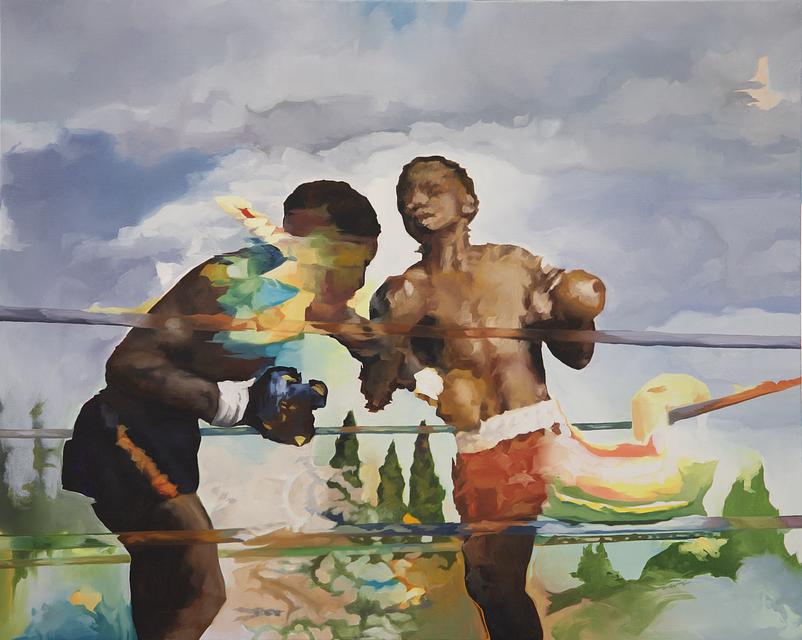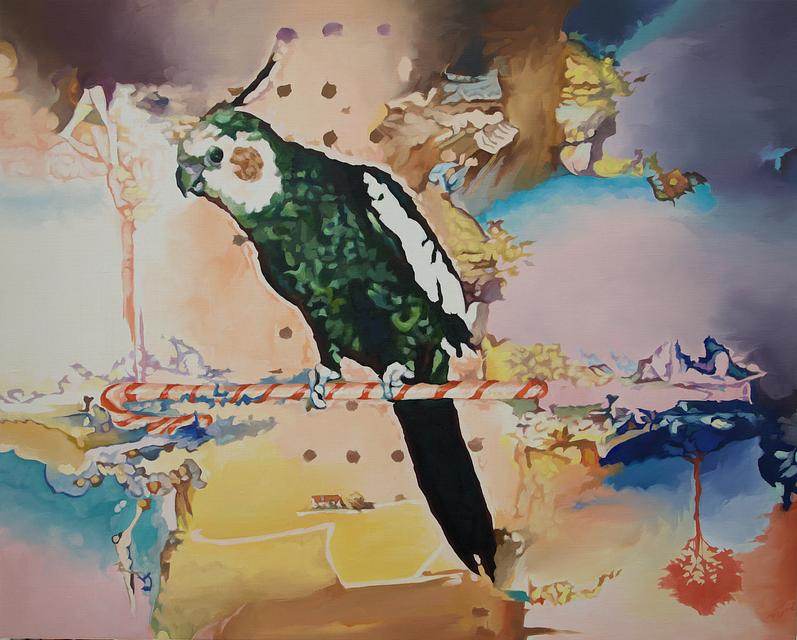"THE LIFE THAT IS ELSEWHERE" - 16 Rue des Quatre Fils, Paris
Click for more information on
We are pleased to present the first solo exhibition of French artist Barbara Navi at Galerie RX&SLAG Paris, curated by Seph Rodney, a renowned critic and essayist, former associate editor of Hyperallergic magazine, contributor to The New York Times, CNN, and MSNBC the American news channel co-founded by Microsoft and NBC as well as co-host of the podcast The American Age.
"My first experience seeing Barbara Navi’s paintings included the feeling of being giddily disoriented, each canvas appearing like a visual history treatise out of which parts have been torn and replaced with other odd moments in the timeline. But spatial and temporal disorientation is not the artist’s goal. Rather it is, in her own words, about creating “a fracture in ordinary time, a caesura in the phrasing of the world.” Through that window, in the moment of held breath we might understand that the life that is elsewhere is actually close at hand. We each have bodies that are constantly moving into a future moment, preparing ourselves for what might be, knowing that we will be called upon to prove we are the right person to do whatever thing we are being asked to do. Simultaneously, we carry our pasts deep inside us, even at the cellular level, where we were phrased by someone else’s tongue long before we answered to a name that we recognized as our own.
Take her painting “Apesanteur” (Weightlessness). What is happening inside this sky? Several kinds of airplanes soar above in a lazy circular formation, not all of them in the same direction. More strangely, they are aircraft originating in different eras, biplanes alongside airliners, alongside modern jet engines. Where are we, and more importantly, when are we? Adding to the paradox of this painting, below the revolving planes is what looks like a tapering column, a tower of Babel, pursuant to the biblical narrative describing an edifice where humans gathered to build ourselves a spire to heaven. Around this structure, on the periphery of the composition are various children dressed in dark clothing, hands idle or with their arms crossed over their chests, waiting for the universe to right itself and stop all this haphazard mixing of time and space. What is happening right now? It’s impossible to tell which is the “real” reality. Is it the children’s world, or the wheeling aircraft of varying technological sophistication, the swirling edifice to human ambition, or the odd indigo pool beneath it all?
Navi’s “Apesanteur” (Weightlessness) doesn’t ever resolve these questions. Instead, the image causes me to waft in and out of present consciousness like I’m recollecting a vague memory of something that I lived through before realizing it was a moment I had only heard or read about.
Living in the present moment is tricky. It requires almost constant attention to what is in front of me right now — a computer screen, and above it, through a window, brownish-red tree branches shaking in the wind, and to my left in the kitchen space, a tea kettle pouring steam into the air. At the same time, I must pay attention to future plans: the trip into the city today to see art and to have a walk with a friend, next week’s travel to New Haven Connecticut, the next month’s responsibilities in Miami. And, choosing to be emotionally healthy, I also regularly look at my past, consider the relationships I’ve had, and talk about them with my therapist to gauge how they have shaped my understanding of who I am, how I love and care for others.
Navi’s paintings within The Life That is Elsewhere impel me to think that these enterprises are not so separate. She suggests that they coexist, that if I tilt my head just so, the past appears, and getting up to fetch my cup of tea, there’s a future apprehensible in the steam.
In her work “Coulisses” (Backstage or Wings) the top of the canvas seems to describe a scene inside a cave where five workers, all of them, with one exception, are dressed in light gray uniforms, performing some kind of labor, perhaps excavation. But underneath them, moving toward the foreground of the painting, is a broad snowy field flecked with green trees. At the bottom of the painting, the field morphs into a stony shelf below which another field of white flowers, held aloft by stalks that are green or yellow, pushes up towards the light. Look, as I do now, again at the cave and you will notice that to its left and right there are holes where an ocean peeks through. The life that is not here, Navi tells me, is always on the edges of our senses, tickling our perception, teasing these senses to expand their grasp.
Throughout the exhibition Barbara Navi conflates several disparate realities tucked into the composition of the painting and makes the boundaries between them porous. They leak into each other. They permit various kinds of emotional, intellectual, and psychic engagement because they feel like something already glimpsed, either dream or in memory. There is a sky inside of this body you have; it is a meeting place for distinct times and heroes.
Gazing at Navi’s paintings out of the corner of your eye you may glimpse that tower of Babel, the myriad languages spoken in your life: the lover who swept up fallen leaves as the world wheeled towards winter, the parent who blew on your tea to cool it before it touched your lips, the person you dream of holding your hand as you step on the plane. They are all here. Now you are able to greet them, acknowledge their presence and see in yourself the wide, azure sky that will never die."
- - Seph Rodney

